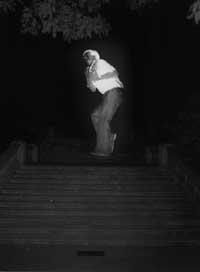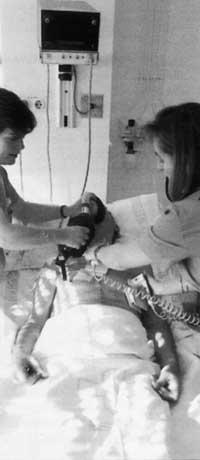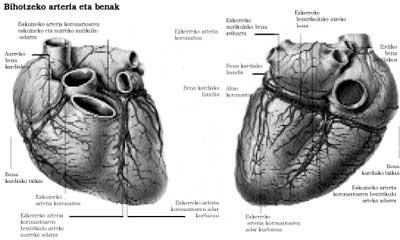Heart ports
This general designation encompasses two different pathological processes: angina and myocardial infarction. In order to clarify the confusion that people have with these serious heart attacks, in this work today I will try to explain the differences of both processes.
Both angina and myocardial infarction have a common origin. The muscle that forms the walls of the heart, that is, the myocardium, receives less blood than normal. When this blood flow drops sharply it is usually angina. However, the infarction is due to the absence of blood in an area of the myocardium, so part of the muscle dies. Therefore, there remains a permanent injury that negatively affects the function of the heart; a kind of scar. No heart muscle dies in angina. Therefore, the injury is not irreversible.
Definitions

We can say that angina pectoris an acute pain in the front of the chest, caused by hereditary, momentary and retrograde insufficiency, at the bottom of the blood supply.
For its part, infarction is a more or less extensive necrosis of the heart muscle, since the local blood supply is abruptly interrupted. More than 90% of cases are caused by coronary artery arteriosclerosis by completely obstructing the inner passage of the arteries. Other heart attacks are due to embolism or spasms in these arteries.
What people are they in?
Angina pectoris almost always a male disease, which occurs from the fourth decade of life. However, it is increasingly diagnosed in young men and also in women (especially during or after menopause), and even more so if there are other risk factors.
Myocardial infarction is also suffered mainly by men aged 40 to 65. In this period it is six times more frequent in men than in women. The proportion over 65 years is two men per woman and from 80 years the incidence is equal in both sexes.
As for predispositions, both diseases are more frequent in smokers, diabetics and hypertensive, or with a high level of cholesterol. Other risk factors are sedentary life and constant psychic and emotional tensions. Therefore, it is normal for angina to fall into people with professions of great responsibility.
Pain, main symptom
Pain is the main symptom of angina pectoris. Pain usually occurs during exercise or in strong emotions. It is usually located at the bottom of the sternum (V. image) and from here to the left arm, neck and gag or lower jaw. In some cases cold sweat, paleness, and distress appear, along with the patient's immediate feeling of death.
However, intense physical exercise is not required to show angina. Sometimes it can be resting (REST ANGINA). Also during sleep. When this happens, the patient wakes up in pain. Resting angina is caused by spasm or blockage of a coronary artery.
Pain is the main symptom of angina pectoris. There may be painless infarction (twenty percent, since the patient only feels very unspecific abdominal discomfort), but without pain one cannot speak of angina pectoris. Fortunately, the pain does not last long (3-10 minutes) and it is important to consider these figures. If the duration is less than the minute, it can almost certainly be said that it is not angina, and if the duration is greater than 10 minutes it should be considered as preinfarction.
Diagnostic Resources
Three are the basic data: pain (how it is, where it is located and where it extends, how long it lasts, etc. ), the changes that appear in the electrocardiogram (quite significant) and the alteration of some enzymes in the blood.
Pain helps the doctor. But as we have said before, one in five of these processes, both the doctor and the patient himself, can happen without realizing it, since there is no pain. On the other hand, the proportion of painless heart attacks can rise to 50% in older people (half). Be careful and don't trust the clinic.
Myocardial cells injured after a heart attack suffer alterations. Therefore, the content of these cells passes into the blood. The analyses allow to detect enzymes mainly from necrotic cells. And so, the percentage of enzymes gives us a fairly precise size of the importance of infarction, since the more they appear in the blood, the greater the part of the heart affected. On the other hand, subsequent evaluations of these enzymes will allow us to know the evaluation of infarction.
Electrocardiogram (ECG) is the record of the electrical activity of the heart muscle. Therefore, when the myocardium deteriorates, and we must not forget that the infarction produces necrosis and cell death, ECG is an appropriate resource (of course in the hands of an expert person), both when it comes to a recent infarction (acute phase) and after the recovery of the infarction (days or weeks after it occurs). The value of CCPV is very varied:
- As a predictive, that is, before the infarction occurs, even if it is not completely certain.
- During stress tests.
- After myocardial infarction, it informs us of the magnitude and evolution of the damage.
What is the importance of the problem?

Infarction has a very poor prognosis if there is any alteration in the transmission of muscle contraction through the heart. Moreover, in some cases complications can become fatal
If we compare both processes, in the case of angina, no cardiac injury occurs. Infarction is the necrosis of an area of the heart, that is, the death of local tissues. In angina, the lack of myocardial oxygen is transient and when exercise (or at least the reason) disappears, oxygenation returns to its normal level. In infarction, however, the lack of oxygen is longer and an injury occurs that, although it cures, not always, leaves a persistent scar. Thus, the autopsy of a person who suffered several angina during his life shows us a completely normal heart. Those who have had a single heart attack (even a light heart attack) have that scar forever in the heart muscle.
Prevention. Can anything be done?
This problem can be seen in two ways.
On the one hand, consider whether coronary arteriosclerosis can be suspended, as this is the main cause of angina. On the other hand, it is necessary to see if it is possible to prevent these episodes of pain.
As far as coronary arteriosclerosis is concerned, sedentary life, smoking cessation, physical exercise or sports (of course, in moderation) and the maintenance of a proper diet should be avoided, completely eliminating animal fats. In addition, in case of diabetes, high blood pressure or excessively high levels of cholesterol, it should be made available to the doctor to provide appropriate treatment.
To prevent coronary pain it is necessary to avoid the factors that cause pain: strong physical exercises, heavy meals and too heavy, cold, large waves and strong emotions. If in spite of all this pain appears you should take the medication indicated by the doctor in each case.
Therefore, those who have suffered some angina always carry a preventive medicine. They are pills that are placed under the tongue and that melt easily. Its goal is to expand the arteries and thus make the blood flow of the heart normal. In any case, they should also be taken before starting an exercise or task that is considered to cause a heart attack. There are also other pills that act longer (about 12 hours).
And after the heart attack, what?
After having suffered a heart attack, all activities that require a greater effort than usual should be done with care and slowness. However, some physical exercise is recommended immediately after the heart attack. The simplest and most convenient is to walk along a flat path. At first a short walk of about ten minutes, the first days. Then, little by little, it will extend until you reach a walk of one or two hours a day. But any activity or sport that causes pain or excessive effort is totally prohibited.
And about sex, what? It is possible to start again as soon as the general condition of the patient allows it, but always in a way that produces the least tension and effort of the patient. It must be taken into account, however, that myocardial infarction is a serious process and that in recovery (as occurs in any other serious disease) the patient does not have much interest in it, especially if they ask for more psychic and physical effort than they can do.
However, do not forget that in infarction there is necrosis in an area of the heart muscle, that is, a fragment of myocardium dies. The affected area loses its characteristics, especially its elasticity and contraction capacity, becoming a fibrous, unrecoverable or “repairable” scar. If the injured part is not very large, the function of the heart is not affected and once the acute phase is overcome the heart returns to its normal. The resulting lesion is only detectable by ECG. However, if the affected area is larger or is located in certain areas of the heart, injuries may appear that will later need treatment. The most common are arrhythmias and heart intakes.
Treatment: What to do in these cases?

In the case of angina pectoris it is necessary to monitor the driving factors (high cholesterol level, hypertension, tobacco use, etc.) and avoid those that start the membranes (intense exercises, stress, etc.) On the other hand, the pain episodes disappear relatively quickly under the tongue with nitroglycerin (placing a pill under the tongue and slowly removing): nitroglycerin is a very suitable vasodilator. Surgery may also be needed in some cases.
Myocardial infarction, in its acute phase, that is, when a heart attack occurs, requires immediate treatment: hard pain relievers to eliminate the pain and move the patient to a hospital to treat possible complications, so that he is admitted to the service or unit where cardiac resuscitation is performed correctly. Once the acute phase is over, the patient may be able to return home after a few days to gradually return to a normal life. The most important factors for heart attack are risk factors (tobacco, inadequate food measures, etc.) is to do without.
And when is surgery necessary? Two are the main reasons for surgery after a heart attack. The first is done to solve the fairly common complication: they soften the affected area (aneurysm) and “inflate”. It is not able to contract, like the rest of the heart, and inside you can form small coacles that can then produce embolisms. Therefore, in some cases it is advisable to extract this aneurysm. The second reason is that by operative means it is possible to improve the blood circulation of the coronary arteries and facilitate the oxygenation of the cardiac muscle. This form of cutting is becoming more and more frequent, currently with complete safety and efficacy, using different surgical techniques.
And what about tobacco?
Tobacco has now been shown to be a very important risk factor for the production of arterial lesions in general and coronary lesions in particular. The more cigarettes burned, the greater the risk of these processes. We don't know exactly what causes this relationship, but it seems that nicotine and tobacco carbon dioxide have something to do with it. Nicotine causes spasms in the arteries while carbon oxide (II) that is breathed along with smoke decreases the level of oxygenation of the blood.
On the other hand, people who burn pipes or cigars have the same risk of coronary heart disease as people who burn cigarettes. Keep in mind that, ending this issue, even if a person does not smoke, is in a smoky environment or next to another person who is constantly smoking, there is a risk of angina.
How should people with angina act? * Recommended:
* Excludes:
|
| Characteristics of pain | Angina pectoris | Pseudo-anginous pain |
Location Geographical distribution |
Behind the breastbone and in the front of the chest A shoulder or both, to the neck, to the gag and to the left arm As a tread Hard exercises with strong emotions, cold and much eaten Rest. Nitroglycerin |
Heart Point To the left shoulder, under the left collarbone and quail. Type of puncture or precipitation. |






